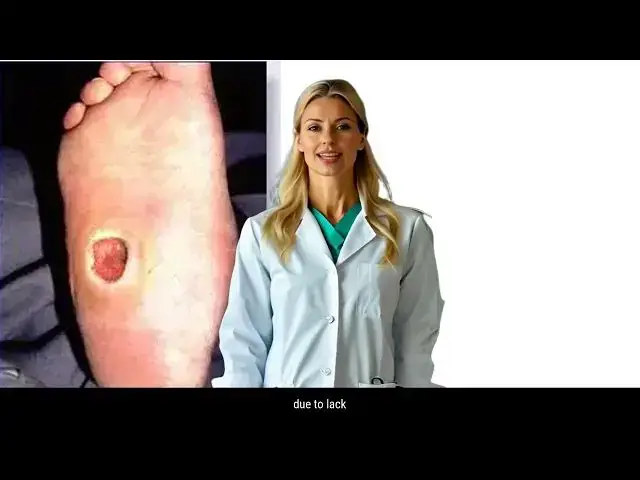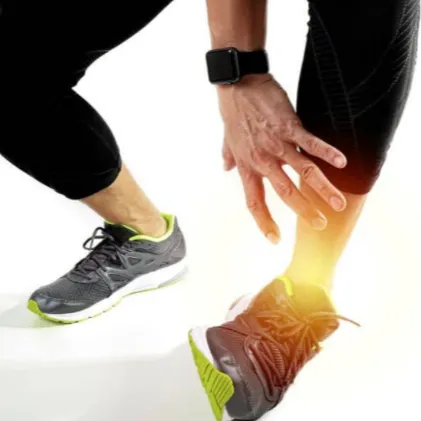@marcbarry1000
A Podiatrist discusses how diabetes can adversely affect the feet, in severe cases, leading to amputation.
For a complete discussion visit: https://www.foot-pain-explained.com/diabetic-foot.html
Show More Show Less View Video Transcript
0:00
in this video we are going to discuss
0:02
how diabetes affects the feet the
0:05
diabetic foot includes diabetic
0:07
neuropathy and peripheral vascular
0:09
disease both of these can have serious
0:13
outcomes estimates run as high as 26
0:16
million Americans suffer from diabetes
0:18
both diagnosed and
0:20
undiagnosed furthermore 25% of people
0:24
with diabetes will develop a foot ulcer
0:26
during their lifetime over half of these
0:29
ulcers will be become infected and
0:31
require hospitalization and 20% of these
0:33
infections will result in
0:36
amputation appropriate Foot Care is one
0:38
of the most overlooked aspects of the
0:40
diabetics daily regimen the feet along
0:43
with the eyes heart and kidneys all have
0:46
the potential for serious consequences
0:48
in a disease that many do not take
0:50
seriously and choose to ignore what are
0:53
the symptoms of diabetic foot pain as
0:55
the disease relates to the foot two
0:57
major events occur as the disease
0:59
progresses
1:00
the first is
1:02
neuropathy many diabetics eventually
1:04
lose sensation in their feet this is
1:07
known as diabetic
1:09
neuropathy there are three types the
1:12
first is autonomic
1:14
neuropathy this this is the simplest and
1:17
earliest type of
1:18
neuropathy it is seen as nothing more
1:20
than dry skin usually accompanied with
1:23
athletes foot the skin on the bottom of
1:26
the feet particularly in the heel area
1:28
will be very dry and scaly the problem
1:31
here is that if the condition is not
1:33
identified properly it can lead to
1:35
breakdown of the skin and
1:37
infection the next type of neuropathy in
1:40
the diabetic is sensory neuropathy which
1:42
presents itself as Relentless burning
1:45
tingling or numbness in the diabetic
1:47
foot the problem with neuropathy is
1:50
multifaceted with lack of sensation on
1:53
the bottom of the diabetic foot a person
1:55
is at risk for stepping on something
1:57
such as a broken piece of glass in the
1:59
kitchen and not even knowing it the area
2:02
then can become infected and at that
2:04
point if the patient blood sugars are
2:06
not under control and the circulation to
2:08
the area is compromised the body is
2:10
unable to heal the infection and in many
2:13
cases can lead to
2:14
amputation factually diabetes is the
2:17
major factor in over 50% of amputations
2:20
performed in the United States each year
2:23
another problem with neuropathy can be a
2:25
Relentless feeling of burning tingling
2:28
or numbness that is not alleviated by
2:30
anything the diabetic does diabetic
2:33
neuropathy usually occurs in both feet
2:35
and will occur continuously day and
2:38
night there are various medications on
2:40
the market for diabetic neuropathy all
2:43
with varying degrees of
2:44
success lria is probably the most
2:47
popularly prescribed medication for
2:49
diabetic
2:50
neuropathy the third type of neuropathy
2:53
is motor
2:54
neuropathy in this situation elevated
2:57
blood sugars will affect the nerves that
2:59
inovate the muscles of the foot and
3:01
lower leg and will cause changes in the
3:03
way the muscles function this abnormal
3:06
function may lead to a more rapid onset
3:08
of hammer toes and bunions as well as
3:10
trophic changes in the muscles
3:12
themselves leading to arthritic changes
3:14
within the feet the other diabetes
3:17
related factor to the feet is peripheral
3:19
vascular
3:20
disease over time diabetes causes the
3:23
arteries going into the feet to
3:25
essentially become clogged and in doing
3:27
so reduces the blood flow to the feet
3:30
this creates various problems the most
3:33
common being the inability of the tissue
3:34
of the feet to get adequate
3:36
nutrition the skin becomes dry thin
3:39
scaly we lose fat on the bottom of the
3:42
feet and the bones become
3:44
demineralized this then makes the foot
3:46
more susceptible to infection and
3:48
difficulty in Walking adequate blood
3:51
flow is necessary to the feet in order
3:53
to help heal wounds if a person cuts
3:56
themselves or steps on a broken piece of
3:58
glass we need need adequate blood flow
4:00
to the area to bring nutrients to repair
4:03
the wound in a diabetic this can be a
4:06
problem due to lack of
4:08
circulation a foot ulcer is usually the
4:10
culmination of elevated blood sugars
4:13
diabetic neuropathy and poor
4:15
circulation so how do we protect the
4:18
diabetic foot the first thing is to
4:21
control your blood sugars no diabetic
4:24
should take their disease for granted
4:26
and should be proactive in their
4:27
approach to their diabetes
4:30
the closer a person's blood sugars are
4:32
kept to normal on a daily basis the less
4:34
damage that is being done this is more
4:37
the case in adult onset diabetes
4:40
otherwise known as type 2
4:42
diabetes next is examination of the
4:45
diabetic foot a diabetic should also
4:48
inspect their feet daily both visually
4:50
and by rubbing their hands along the
4:52
bottom of their feet feeling for
4:54
anything that may not feel normal
4:56
anything questionable observations
4:58
should be brought to the attention of
5:00
their foot specialist
5:02
immediately for older individuals who do
5:04
not bend very well placing a mirror on
5:07
the floor and lifting your foot over the
5:09
mirror is a good way to visually inspect
5:11
your feet the next protection is
5:14
moisturizing your feet the feet should
5:16
be hydrated daily to keep the skin soft
5:19
and supple for most people a good hand
5:22
cream will work just fine as previously
5:25
mentioned diabetics tend to have drier
5:28
skin than the general population and
5:30
thus the skin is more prone to breaking
5:32
down the goal is to keep the skin from
5:35
breaking down which can lead to
5:37
infection and that's what we're looking
5:38
to avoid the cream should be used daily
5:41
and some individuals may have to apply
5:43
the cream more than once per day next
5:46
proper daily hygiene which includes
5:49
washing the feet well with soap and
5:50
water including in between the toes then
5:53
drying them very well once again
5:56
application of good Hydrating Lotion is
5:58
recommended immediately ately
6:00
thereafter this is especially important
6:02
in the winter months when skin in
6:04
general gets dry due to low humidity in
6:06
the air next proper fitting shoes are
6:10
also very
6:11
important diabetics should wear
6:13
non-constricting shoes as shoes that are
6:16
too tight will cause unnecessary
6:17
pressure points on the feet which can
6:19
break down and become infected in an
6:22
effort to avoid pressure points many
6:25
patients will go out and buy larger
6:27
shoes there is a fallacy with this logic
6:31
shoes that are too big will cause the
6:33
feet to have excessive motion within the
6:35
shoe which will also create friction
6:37
eventually leading to breakdown of the
6:39
skin along with a good pair of shoes a
6:42
diabetic should also have a good pair of
6:44
orthotics to support their feet when
6:47
there is abnormal sensation and the
6:49
patient cannot really feel the ground
6:51
the Bony architecture of the foot will
6:53
begin to break down an orthotic helps
6:56
keep the foot upright and prevents
6:58
abnormal stresses plac B upon it lastly
7:01
no diabetic should ever take a sharp
7:04
instrument to their feet in what we
7:05
refer to as bathroom surgery if there is
7:08
something on the foot that is of concern
7:10
such as an ingrown nail or a painful
7:12
corn it should immediately be brought to
7:15
the attention of a foot
7:16
specialist trying to cut out an ingrown
7:19
nail or trim a corn are examples of
7:21
conditions that are better left to The
7:23
Experts working to keep your blood
7:26
sugars controlled and paying attention
7:28
to any changes in your feet is the best
7:30
way to prevent foot problems down the
7:31
road
#Blood Sugar & Diabetes
#Blood Sugar & Diabetes


